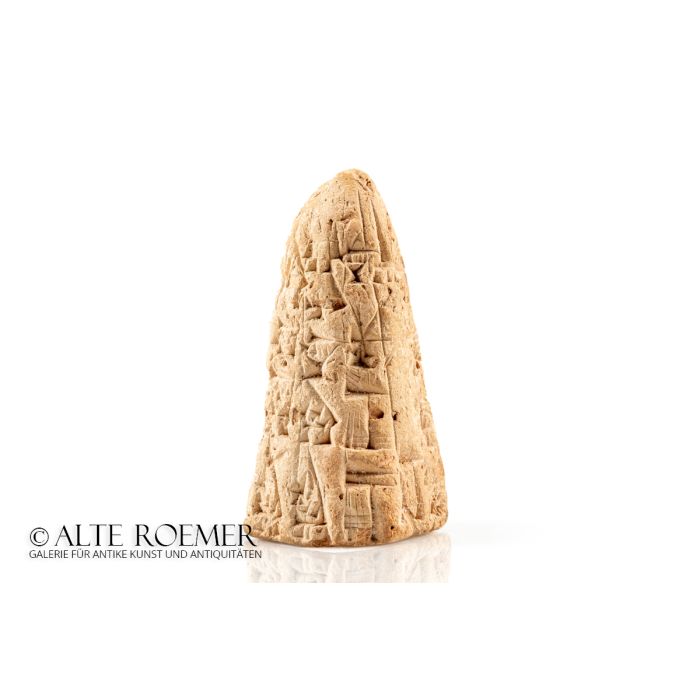Sumerian foundation cone from Uruk
Price: on request
Sold
Object number
AR3262B
| Object: |
Sumerian foundation cone
|
| Material: |
Clay.
|
| Period: |
3rd Millenium BC to beginning of the 2nd Millenium BC. Early Bronze Age of Mesopotamia. |
| Description: |
Small conoid clay nail with cuneiform inscription to one side of it over its full length. The inscription names the sanctuary "É-an-na" and ends with Sumerian "mu-dù" for "he built". The sanctuary, also spelled Eanna, Sumerian for "House of Heaven", was the main temple of Uruk. With its mention in the Epic of Gilgamesh, the structure has an honored position in the first piece of literature in human history. This makes the foundation cone quite exciting, having a connection to both, the early history of the city of Uruk and the beginning of literary history. |
| Background: |
Foundation cones were widespread in Mesopotamia and especially among the Sumerians in the 3rd millennium BC. They were almost always made of clay, with a dedication in cuneiform script impressed before firing. The hardened clay cone was then stuck like a nail into the still wet clay wall of an important building, usually a temple. The inscription dedicated the temple to a god, but certainly did not forget to mention which king ordered its construction and thereby distinguished himself particularly in the face of the gods.
|
| Dimensions: |
5.3cm length.
|
| Condition: |
Very good condition, possibly parts of the front and rear end broken off and missing.
|
| Provenance: |
Acquired by us in 2021 on the German art market. Previously in the German private collection of Helge Deikner (1926-2021). Acquired into the collection in the 1970s or earlier. It was passed on that this piece was a gift from the archaeologist Dr. Julius Jordan. He was in charge of the German excavation campaign in Uruk from 1912 to 1913 and from 1928 to 1931, and was also entrusted with other archaeological and conservational tasks in Iraq in the 1920s and 1930s. Together with the self-declaration of the foundation cone as belonging to the temple of Uruk, it seems certain that the piece is a find from Uruk. An enormous body of artefacts bearing early writings has been recovered there and was preserved since the 1850s. Not all texts have been deciphered and translated by a long shot. |
| References: |
Cf. Metropolitan Museum of Art, acc. no. 1971.71. Cf. B. Jensen, Cuneiform Objects at the Museum of Peoples and Cultures, Studia Antiqua 13, no. 2 (2014), acc. no. 1977.040.11. |
| Authenticity: |
We unconditionally guarantee the authenticity of every artefact, all items are subject to our lifetime return policy on authenticity.
|


